Use the validated GARCH model in production
GARCH Models in R

Kris Boudt
Professor of finance and econometrics
Use in production
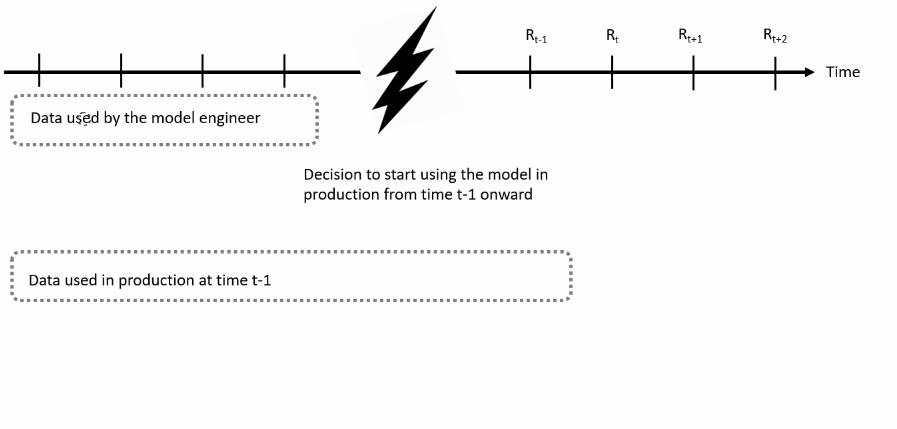
New functionality
- Use
ugarchfilter()for analyzing the recent dynamics in the mean and volatility - Use
ugarchforecast()applied to augarchspecobject (instead ofugarchfit()) object for making the predictions about the future mean and volatility
Example on MSFT returns
msftret: 1999–2017 daily returns.- Suppose the model fitting was done using the returns available at year-end 2010.
- You use this model at year-end 2017 to analyze past volatility dynamics and predict future volatility.
Step 1: Defines the final model specification
Fit the best model using the msftret available at year-end 2010:
# Specify AR(1)-GJR GARCH model with skewed student t distribution
garchspec <- ugarchspec(mean.model = list(armaOrder = c(1,0)),
variance.model = list(model = "gjrGARCH"), distribution.model = "sstd")
# Estimate the model
garchfit <- ugarchfit(data = msftret["/2010-12"], spec = garchspec)
Define progarchspec as the specification to be used in production and use the instruction setfixed(progarchspec) <- as.list(coef(garchfit)):
progarchspec <- garchspec
setfixed(progarchspec) <- as.list(coef(garchfit))
Step 2: Analysis of mean and volatility dynamics
Use the ugarchfilter() function:
garchfilter <- ugarchfilter(data = msftret, spec = progarchspec)
plot(sigma(garchfilter))
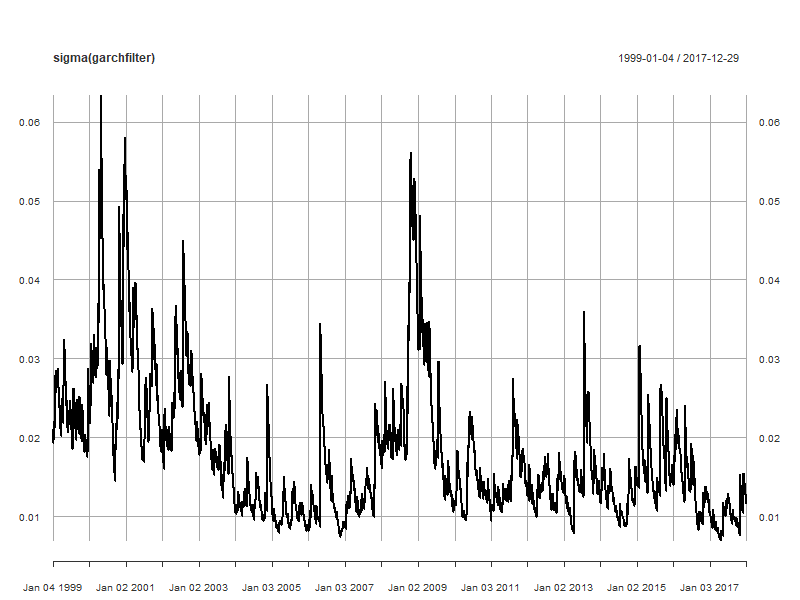
Step 3: Make predictions about future returns
garchforecast <- ugarchforecast(data = msftret,
fitORspec = progarchspec,
n.ahead = 10) # Make predictions for next ten days
cbind(fitted(garchforecast), sigma(garchforecast))
2017-12-29 2017-12-29
T+1 0.0004781733 0.01124870
T+2 0.0003610470 0.01132550
T+3 0.0003663683 0.01140171
T+4 0.0003661265 0.01147733
T+5 0.0003661375 0.01155238
T+6 0.0003661370 0.01162688
T+7 0.0003661371 0.01170083
T+8 0.0003661371 0.01177424
T+9 0.0003661371 0.01184712
T+10 0.0003661371 0.01191948
Use in simulation
Instead of applying the complete model to analyze observed returns, you can use it to simulate artificial log-returns:
$$ r_{t} = \log(P_{t}) - \log(P_{t-1}) $$
Useful to assess the randomness in future returns and the impact on prices, since the future price equals:
$$ P_{t + h} = P_{t} \exp(r_{t + 1} + r_{t + 2} + \ldots + r_{t + h}) $$
Step 1: Calibrate the simulation model
Use the log-returns in the estimation
# Compute log returns
msftlogret <- diff(log(MSFTprice))[-1]
Estimate the model and assign model parameters to the simulation model
garchspec <- ugarchspec(mean.model = list(armaOrder = c(1, 0)),
variance.model = list(model = "gjrGARCH"),
distribution.model = "sstd")
# Estimate the model
garchfit <- ugarchfit(data = msftlogret, spec = garchspec)
# Set that estimated model as the model to be used in the simulation
simgarchspec <- garchspec
setfixed(simgarchspec) <- as.list(coef(garchfit))
Step 2: Run the simulation with `ugarchpath()`
Simulation using the ugarchpath() function requires to choose:
spec: completely specified GARCH modelm.sim: number of time series of simulated returns you wantn.sim: number of observations in the simulated time series (e.g. 252)rseed: any number to fix the seed used to generate the simulated series (needed for reproducibility)
simgarch <- ugarchpath(spec = simgarchspec, m.sim = 4,
n.sim = 10 * 252, rseed = 12345)
Step 3: Analysis of simulated returns
Method fitted() provides the simulated returns:
simret <- fitted(simgarch)
plot.zoo(simret)
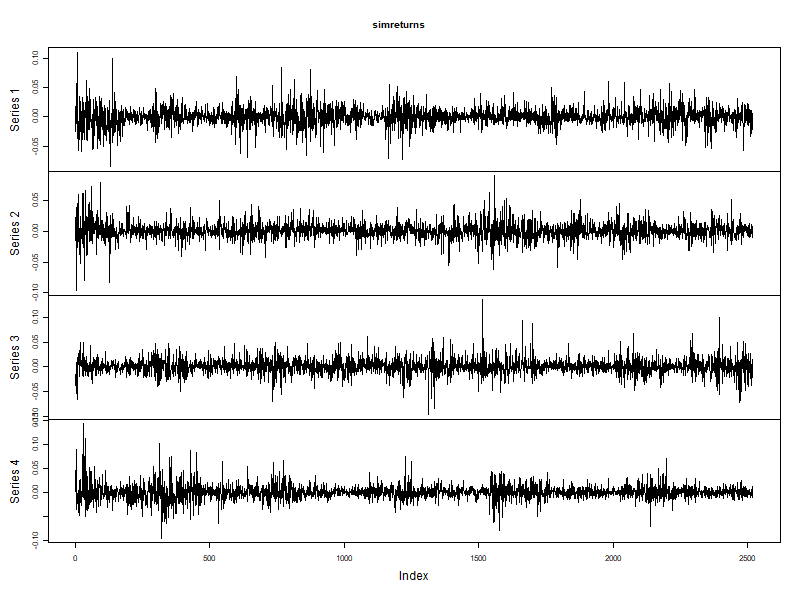
Analysis of simulated volatility
plot.zoo(sigma(simgarch))
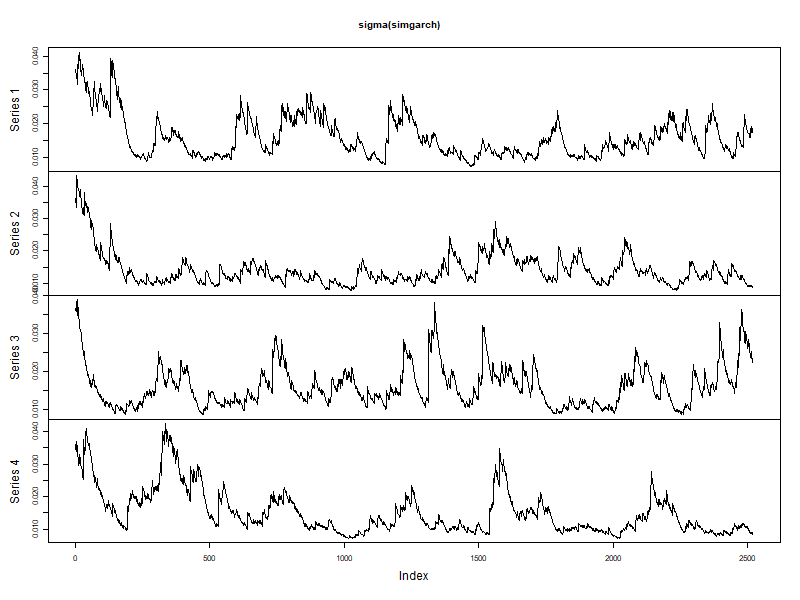
Analysis of simulated prices
Plotting 4 simulations of 10 years of stock prices, with initial price set at 1:
simprices <- exp(apply(simret, 2, "cumsum"))
matplot(simprices, type = "l", lwd = 3)
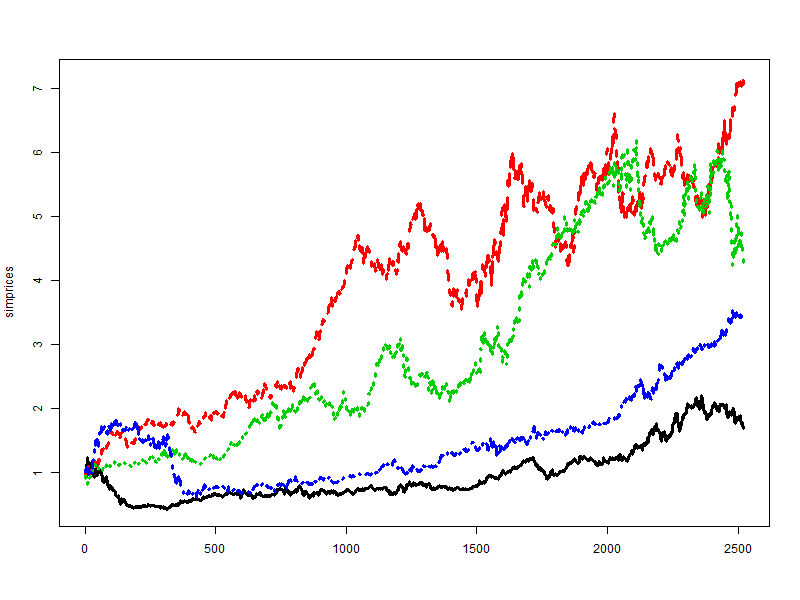
Time to practice with setfixed(), ugarchfilter(), ugarchforecast() and ugarchpath()
GARCH Models in R

